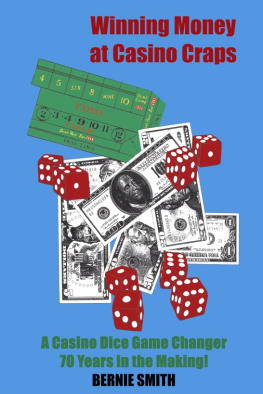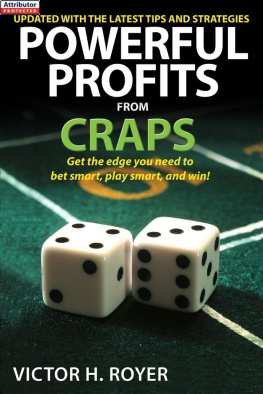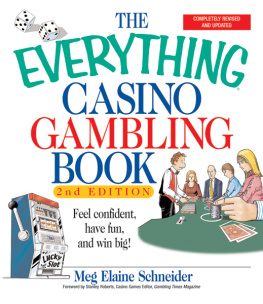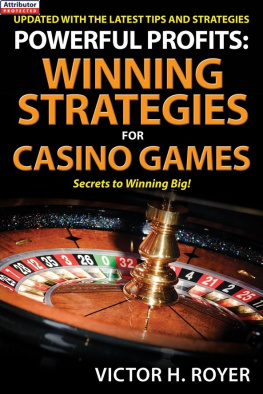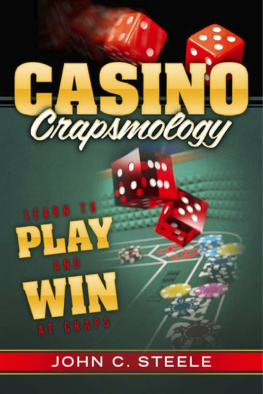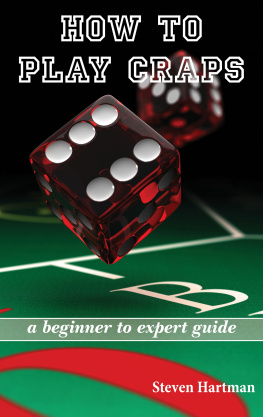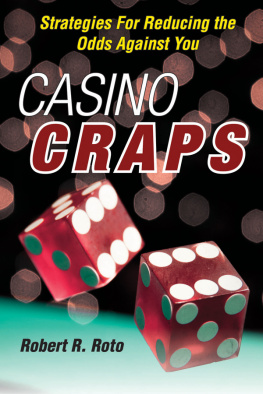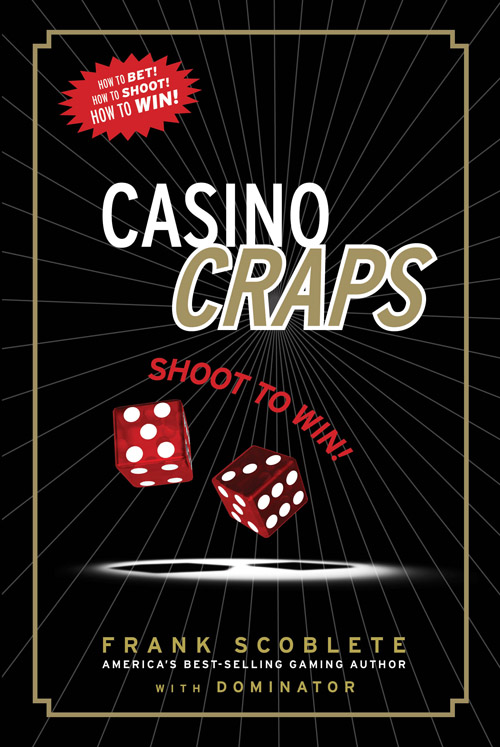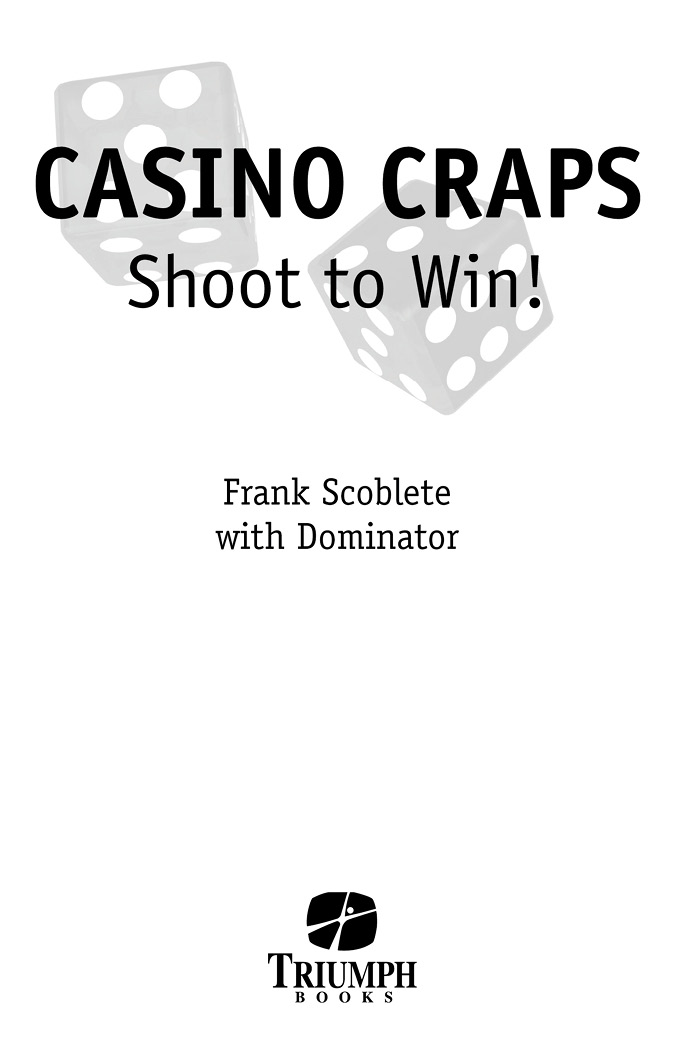
~
For
The Captain
Who brought modern dice control to the table
and
The Arm
The greatest dice controller of all time.
They will always be remembered.
For Carlo, Concetta, and Anna LoRiggio, I miss them... Dominator
Contents
Acknowledgments
We have to give a big thanks to John Skinny, who checked over the contents of the book several times, giving me valuable aid. Also to Jerry Stickman who helped us with his expertise and to Billy the Kid for allowing us to use his rant.
Foreword. The Captain Invented the Modern Dice-Control Movement
T he Captain of Craps, the Atlantic City legend, was responsible for discovering how to beat the modern casino game of craps with controlled shootingwhich he used to call rhythmic rolling as well as controlling the dice. He applied this technique to beat the casinos from the late 1970s through 2007almost 30 years of constant play. Yes, he won millions.
Since 1998, some writers have tried to take away the dice-control laurels from the Captain and assign them to other people who merely tried to build (sometimes incorrectly) on what the Captain had created. These pretenders to the throne are many, of course, because a good idea is always worth pilfering.
In 1993, my book The Captains Craps Revolution! was published, and in it the Captain addressed the issue of controlled shootinglong before any of the pretenders came out of the woodwork to try to take credit for this brilliant technique and his brilliant ideas. Here is an excerpt from the above-referenced book:
The Captain: I dont need to guess. I know that some people have trained themselves privately or at the tables to control the fall of the dice. The Arm has had remarkable success fixing [setting] and controlling the dice. The Arm consistently has major rolls. Recently at the Sands casino in Atlantic City, during a Sinatra weekend, with the place packed with freewheeling high rollers, and then several days later at the Claridge right across the street, the Arm had monster rolls of positively legendary proportions. This isnt coincidence or merely fluctuations in randomness. The Arm controls the dice! [Bold lettering mine]
Does it mean that every time the Arm picks up those cubes, a big one is coming? Of course not. There are times when she isnt at the right spot on the table or the throw is a little off. Having played with the Arm for years, I can recognize the signs of an off night. So can she. But if the groove isnt there, just like a pitcher, the Arm leaves the game and does not roll.
When we talk about fixing and controlling the dice, we arent looking for perfection. Pitchers dont pitch perfect games every time out. In fact, each separate roll of the dice to a player who can control them is like a pitch in a game. The good pitchers will consistently throw strikes and have good games, not every time out, but enough that you can say this isnt just randomness or luck. Also, you have to define what you mean by a good roll. My definition is simple: a good roll is one where the seven doesnt show long enough to make me money or one where I can make a good profit because there is a rapid succession of repeating numbers. Fixing and controlling the dice has more to do with certain numbers being repeated than it does with monster rolls. You dont have to have monster rolls to win. Ive seen rolls by the Arm where the four will come up four or five times in a row, followed by some other numbers, then another string of fours before sevening-out. Its a wonderful feeling to be up on only one number after the 5-Count [more on this coming up] and have that number hit repeatedly in rapid succession. People who can control the dice will tend to have certain faces of the dice appear more often than these faces would otherwise by chance.
In the book, the Captain then continued about how one should practice to actually get control over the dice, how many rolls one should do to see if such control was actually there. He mentioned that he sometimes had control but other times he didnt, but he denied he was very good at it. He thought of himself more as a rhythmic roller, which is, I guess, the equivalent to control light. I also guess that assessment of himself was his humility talking, because in my more than a dozen years of steadily playing with him (and the Arm) in the late 1980s and 1990s, he was damn good and had the prototypical roll that works best for most controllers. He was aware that using the word control meant a high degree of accuracy with the diceso he considered himself more of an influencer. This coming from a man who rolled 100 times and 147 times before sevening-outthe only player who has had two hands of 100 or more rolls!
To me the use of words such as dice control, rhythmic rolling, and dice influence all mean the same thing: the shooter has the capability to get an edge over the casinos.
Unlike today, when you can find controlled shooters in greater numbers, in the Captains early days they were few and far between. But they were there. The greatest of them was the Arm, and the most brilliant of them was the Captain.
The Captain was the first to fully understand dice control and its ramifications, and no amount of taking his words out of context or trying to give the laurels to someone else who arrived on the scene years after him can take these achievements away from him. All the current vocabulary of dice control, all the analogies to baseball or golf or other sports, all the talk about being at the right spot on the table, all of our understanding of when to leave the table, all the knowledge that repeating numbers can also be the way to win money even without monster rollsyes, all the modern parlance of the dice-control worldcame from him.
Dominator and I could never have written this book if the Captain hadnt existed. Read this and learn from him.
The Captain was the man then, and he will remain the man forever.
Please note: Although this book is a joint effort between Frank Scoblete and Dominator, the voice will be Franks, and it is written in the first person.
1. Welcome to the Wonderful World of Craps
T o a new player, craps looks like a most intimidating game. Just look at that layout; it resembles an ancient Egyptian tablet covered in hieroglyphs that tells some elaborate sacrificial story. Nothing could be further from the truth. Craps is a simple game, made even simpler because most of the bets are worthless to the smart player, although ploppiesthe unschooled, unthinking masses of casino craps playerswill fall all over themselves to wager on them.
If you have never played craps before or if you are a veteran looking to get an edge or a new craps player looking to learn the game and get an edge, then this book is for you. Ill explain how the game is played and the various bets of the game. Because most of the bets at the craps table are a waste of your time and, more important, a serious waste of your money, this book will be a heads up for you gamblers. Ill explain why that is true, and I will use house-edge percentages and also what kind of money edges the casinos really have on each and every bet. This book can lead you to an advantage over the casinoand that would be a great thing for you, wouldnt it?
So, here we go!
The Dice
A die has six sides, so there are 36 possible combinations of two dice in the game of craps: six sides six sides = 36 combinations. Each side (or face) of a die will have various numbered pips: 1-pip, 2-pips, 3-pips, 4-pips, 5-pips, and 6-pips. Given two dice, the lowest number that can be rolled is a 2 (1-pip + 1-pip); the highest number is 12 (6-pips + 6-pips). There is only one way to make a 2 and only one way to make a 12. The following graph shows you the possible combinations that can be made with two dice.


